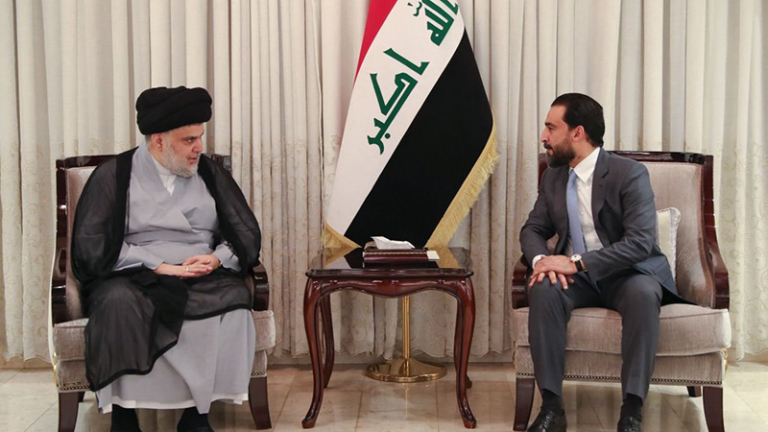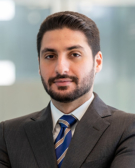
The current political deadlock in Iraq’s government formation since the early October 2021 parliamentary elections is caused by intra-group political competition rather than inter-group rifts and rivalries. Major ingroup rifts within Iraq’s main ethno-sectarian and traditional powerhouses were observed since the early stages of the post-election political maneuvering. These began with a difficult and serious intra-Shia rivalry between the Sadrist Movement that won the largest plurality of seats in the elections and pro-Iran Shia parties coalescing under the Coordination Framework (CF). An intra-Kurdish split emerged between the Kurdistan Democratic Party (KDP) and the Patriotic Union of Kurdistan (PUK) over the Iraqi federal presidency. The latest of these schisms is a major split within what was the only remaining unified sectarian front, the Sunni Sovereignty Bloc. Parliamentarian Muthanna al-Samarrai exited the trilateral alliance between Sadr, KDP, and Sovereignty (recently labeled ‘Save the Homeland’ Alliance) and joined the Shia Coordination Framework with some colleagues in al-Azm Coalition.
In essence, Iraq today has two major opposing fronts: the first comprises the Sadrist Movement, the Kurdish KDP, and the Sunni Sovereignty Bloc, uniting under the Save the Homeland Coalition, and the second is composed of the Coordination Framework, the Kurdish PUK, and the Sunni al-Azm, operating under the National Persistence Alliance. Such a division between cross-sectarian alliances in a supposedly consociational democratic system confirms three interrelated political developments in today’s Iraq: first, Iraq’s traditional political players are obviously exploiting the transition in the country from identity to issue politics; second, Iraq’s internal divisions are more a result of a party distribution of spoils (muhasasa between parties) than a confessional one (muhasasa between sects); third, there are clear and alarming signs of major crises within the various forces of the political class in the post-Tishreen (October 2019 uprising) era.
Intra-Shia Rivalry: A Politico-Religious Contest
There are many layers to Iraq’s intra-Shia rivalry that go beyond politics, such as struggles over Najaf’s religious establishment, Shia-majority populated provinces, the senior leadership and resources of the Popular Mobilization Forces (PMF), and other forms of power bestowing legitimacy on any party as a representative of the community. The process of government formation after the October 2021 elections witnessed serious divisions and differences between the traditional Shia political power players: the Sadrist Movement and the Coordination Framework. The former claims to lead Iraq in a more nationalist approach, eschewing external interference by Iran in the formation of a majority government, while the latter is known for its close ties to Tehran and calls for cobbling together the usual consensus government that includes all political parties.
The process of government formation after the October 2021 elections witnessed serious divisions and differences between the traditional Shia political power players.
While the current intra-Shia rift is not a product of the latest elections—which gave the Sadrists a clear and decisive victory—it is arguably at its most apparent stage since the 2003 invasion of Iraq that resulted in Shia supremacy. The failure of the CF parties in the elections can be blamed on the fact that the October 2019 protest movement derived its impetus from the Shia-majority provinces in the country. The protests were a clear and alarming sign of a public Shia grassroot rejection and dissatisfaction with what were presumed to be the community’s political representatives who had failed to reform such essential sectors as education, health care, infrastructure, electricity, and employment, among others.
Intra-Kurdish Rivalry: Reshuffling Political Power
The stalemate in naming and appointing a president for Iraq following the re-election of Speaker of Parliament Mohammed al-Halbousi is driven by an ingroup disagreement within the Kurdish camp. The post-2003 political distribution of Iraq’s three leading positions is based on an ethnic-sectarian quota known as the muhasasa system according to which the premiership is allocated to the Arab Shia, the speakership of Parliament to a Sunni Arab, and the presidency to a Kurd. This does not necessarily mean that any independent person or technocrat can be eligible as a candidate for any of the different positions just because he fits the ethnic or sectarian criteria. Instead, candidacy and eligibility are determined by the degree of support such an individual can secure from the traditional political forces.
The geographic monopoly over certain areas within the Kurdistan Region of Iraq is also administratively, politically, and militarily divided between the Barzani and Talabani tribes.
Within the Kurdish political arena, there is another pattern of power-sharing agreements where the KDP heads the Kurdistan Regional Government (KRG) and the PUK chooses the Kurdish candidate for Iraq’s presidency. The geographic monopoly over certain areas within the Kurdistan Region of Iraq (KRI) is also administratively, politically, and militarily divided between the Barzani and Talabani tribes, the leading families in control of the KDP and PUK, respectively. Given the allegedly decreasing influence and fragile unity within the PUK and its leadership following the death of longtime political godfather, Jalal Talabani, the KDP found an opportunity to expand its influence by sidestepping the Kurdish customary agreements regarding Iraq’s post-2003 political system at the regional and federal levels by pushing for its own candidate to be Iraq’s president, while still maintaining its KRG dominance.
Current Iraqi President Barham Salih, a PUK partisan, was first challenged by KDP’s candidacy of Hoshyar Zebari, former Iraqi foreign and finance minister. KDP used its strong position within the Save the Homeland Coalition to nominate Zebari, but his presidential bid was rejected by Iraq’s Federal Supreme Court. In 2016, corruption allegations were levied against him while he was finance minister and he lost a vote of confidence in parliament. The still unresolved allegations cost him his candidacy and Muqtada al-Sadr, leader of the Sadrist Movement, found it necessary to pull his support because he did not “meet the conditions” for becoming president. But KDP insisted on nominating a replacement from among its partisans and chose Reber Ahmed, the KRG’s interior minister, to challenge sitting President Saleh.
While conditions for electing a president do not appear to have ripened, considering the KDP-PUK rift, the latter has called for electoral reforms in Kurdistan ahead of KRI’s next parliamentary elections, scheduled for October 1, 2022. The PUK and other small Kurdish parties are interested in changing the electoral law that they say allows the KDP to benefit from the quota allocated for minorities in the regional parliament. Such benefit has increased the KDP’s influence over all aspects of Kurdish life in the KRI, but also has added to its power on the federal level in Baghdad.
Intra-Sunni Rivalry: Opportunity-oriented Breakup
The internal rift within the Sunni political parties that participated in the last elections and that are involved in the current negotiations to form a government is the latest episode of the recently emerging intra-sectarian political divisions. The leading Sunni political parties united in the first session of the new legislature on January 9 to elect Mohammed al-Halbousi as speaker, and that was despite a short-lived competition between him and Khamis al-Khanjar, another Sunni leader in the Sovereignty Bloc. The Sovereignty leaders put aside their differences in order for Halbousi to reclaim his post and for Khanjar to lead the bloc under the umbrella of the Save the Homeland Coalition in order to prevent further losses in a much more complex and hostile political environment.
The prolonged and unresolved political dispute between the two leading Shia coalitions and between the Kurdish political parties may have had spillover effects on Sunni political unity.
The prolonged and unresolved political dispute between the two leading Shia coalitions—the Sadrists and the Coordination Framework—and between the Kurdish political parties may have had spillover effects on Sunni political unity by motivating the latter group’s internal differences to seek alternative outgroup alliances. The Sovereignty Bloc witnessed a split where 12 of its members—led by Muthanna al-Samarrai—joined the CF. This act helped the National Persistence Alliance to appear to have a similar ethnic and sectarian composition as the Save the Homeland Coalition. But Persistence lacks the number of deputies in parliament to be able to form a government. This is why the Coordination Framework insists on a consensus government where all parties participate as opposed to the Sadrists who want to form a majoritarian cabinet.
A New Layer of a Shia-Driven Intra-Sunni Competition
Ali Hatem al-Sulaiman, the Sheikh of the Dulaim Tribes in Iraq returned to the country from an 8-year-long exile after being accused of terrorism following a major rift with former Prime Minister Nouri al-Maliki. Many believe that Maliki himself facilitated the return in order to strengthen the Sunni—specifically Anbari—presence in the CF in an attempt to challenge the Halbousi-Khanjar duopoly in Save the Homeland.
Sulaiman is not the first prominent Sunni political figure to return to the political arena through the facilitation of the very same Iran-backed Iraqi Shia politicians who led the campaigns accusing them of terrorism and corruption. Former finance minister and prominent Sunni politician Rafi al-Issawi was also released from prison last month, and there are rumors regarding the possible return of former Vice President Tariq al-Hashemi who is also known as the most prominent Sunni exiled politician in post-2003 Iraq. It thus appears that the Coordination Framework is sidestepping its intra-Shia struggle and rivalry with the Sadrists while simultaneously weakening them by threatening the position of Speaker Halbousi through Sunni figures who can challenge his political position and influence in Anbar province.
Cross-Sectarian Discourse Under the Shadow of Intra-Sectarian Competition
It is difficult to predict an outcome of the current political stalemate in Iraq considering the delayed choices for prime minister and president. Uncertainties abound. The Sunni parties’ split means that neither the Save the Homeland nor the Persistence alliances can depend on the Sunnis during a prolonged political deadlock. KDP may reconsider its accord with Sadr against the Coordination Framework as it may face pressures in Kurdistan over electoral reforms there. The Sadrist movement may find that it is easier to reach a deal with the Persistence Alliance if the latter offers some compromises. Even the CF may reconsider its priorities and find an acceptable deal with Sadr without involving his major foe Nouri al-Maliki. Moreover, the Sadrist leader has also allegedly approached the few Tishreen forces such as Imtidad to increase his parliamentary presence and avoid compensating for the CF. Yet, it is not clear whether Sadr would be able to manage the interests of the protest movement and independent forces such as Imtidad and the Kurdish New Generation Party—where both have already presented 17 conditions for their participation, which include the appointment of a technocratic and independent prime minister. The Save the Homeland Coalition has nominated Reber Ahmed for president and Jaafar al-Sadr, Moqtada’s cousin and Iraq’s ambassador to the United Kingdom, for the premiership.
It is difficult to predict an outcome of the current political stalemate in Iraq considering the delayed choices for prime minister and president.
Indeed, current political conditions, the seeming unwillingness of the parties to offer needed compromises, and the nature of the political system promise continued uncertainties for Iraq. All the political forces, from Speaker Halbousi to nominees Ahmed and Jafar al-Sadr to all the other figures involved in the government formation process, are official members of the traditional political factions benefiting from the current political system. They are the ones against whom the Tishreen protest movement has rebelled. It is hard to see how they can be expected to end political sectarianism, corruption, or the muhasasa system. Indeed, absent a real vision for change, Iraq is expected to continue to witness inter- and intra-group rivalries over the spoils of the political system.

